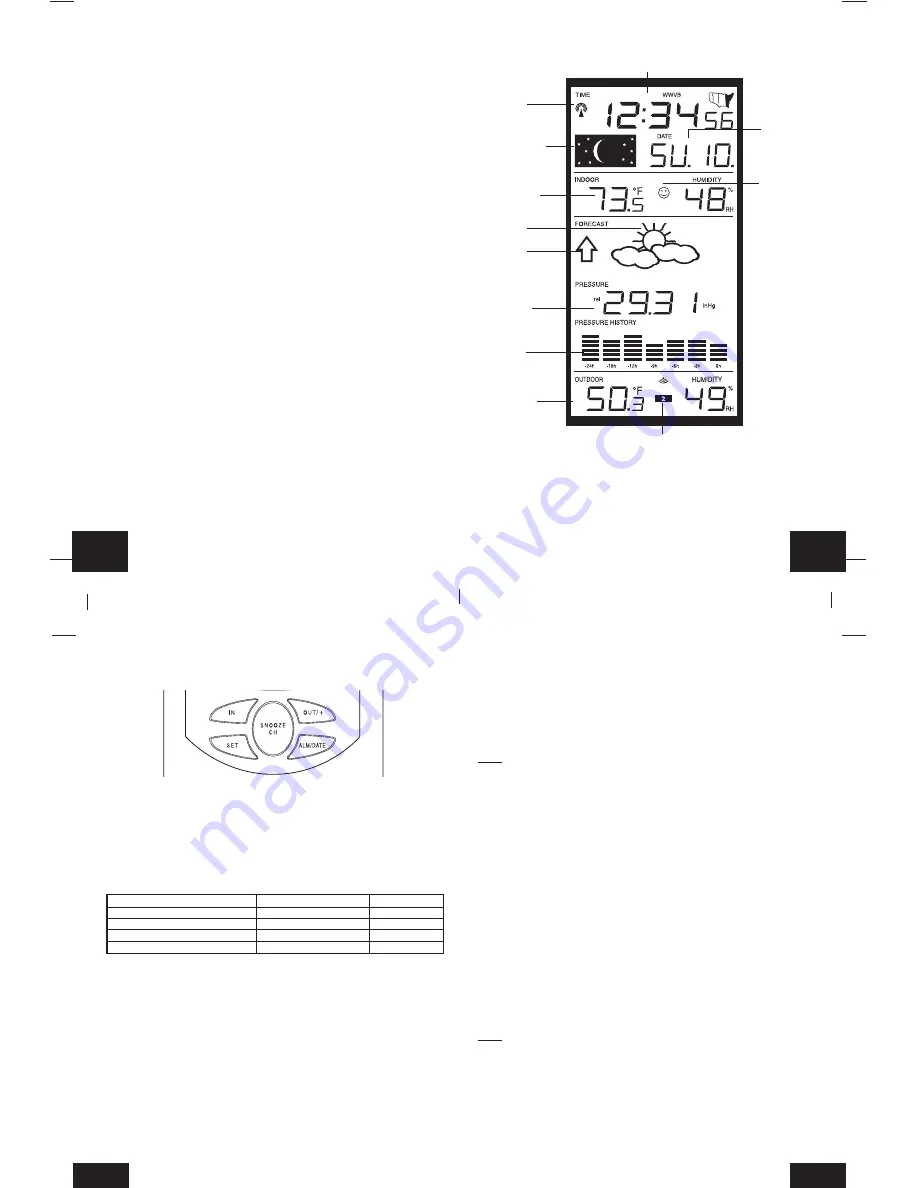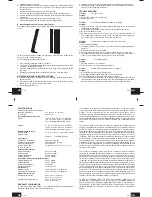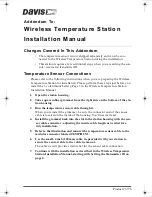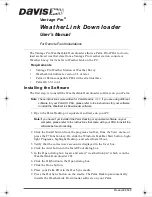
3. Do not press any buttons for at least ten minutes. If a button is pressed before the
indoor weather station has received information from the TX4U sensor, no data
will be received from that sensor until reset.
4. Replace the battery cover.
II. Start Up Sequence
A. Initial Start
1. Immediately after the batteries have been installed, the indoor weather station
will sound a “beep”, and the LCD will completely light up for a brief moment.
2. All information will then appear in normal mode, with “12:00” as the default time
and “TH.1” as the default date (2004 as the year).
3. The indoor temperature and humidity, and barometric air pressure (as 29.91 inHg
relative RH) will also be displayed.
4. There is a “satellite” icon that appears in the bottom portion of the LCD, between
the outdoor temperature and humidity - this icon informs the user that the indoor
weather station is looking for signals from the remote thermo/hygro sensor. Within
five minutes the remote temperature and humidity should be displayed-if not,
remove batteries from all units and repeat battery installation, the remote tem-
perature sensor first, then the indoor weather station.
B. WWVB Reception
1. Once the batteries are installed in the Weather Center, it will automatically search
for the WWVB signal. If it receives a good signal (which is unlikely during daylight
hours in most locations), the WWVB reception indicator (looks like a tower icon)
will flash. The indoor weather station requires five full minutes of good reception
to successfully capture the signal and set to the correct hour, minute, second,
month, day and year. If the signal reception is not successful within ten minutes,
the signal search will be cancelled and will automatically resume every two hours
until the signal is successfully captured.
2. The signal is sent from Ft. Collins, Colorado only and is similar to an AM radio
signal. Atmospheric interferences such as storms, sunspots, and even sunlight
will cause the signal to not travel as far.
3. To maximize reception, place the indoor weather station in a window facing
Colorado, at least six feet from any electrical source (computers, televisions,
refrigerators, etc.). Do not move the indoor weather station while it is searching
for the signal.
4. The time and date can be manually set. Once the signal is captured, it will over-
ride any time and date set to the time zone selected.
5. Once the time and date are set, the indoor weather station will conduct a search
every night at midnight and correct to the accurate time and date (Daylight Sav-
ing Time is automatic). If the signal has been received in the past 24 hours, the
reception indicator will be displayed.
III. Explanation of LCD Information
A. The below picture highlights the LCD features.
B. There are many different modes the indoor weather station can be set to. The
LCD shown is the normal operating mode, and your actual data shown will be
different based on your local settings and conditions.
IV. Function Key Layout
A. The below picture shows the five function keys used in programming and opera-
tion of your indoor weather station
V. Program Mode
The program mode is laid out in a manner that allows you to program each function
separately, or you can follow the instructions entirely to program the indoor weather
center. Complete programming is usually done for the initial set-up, and will require
you to skip step 1,2 and 3 of each programming section. The programming mode
can be exited at any time by either pressing the “Snooze/CH” button, or waiting for
the 15-second time-out to take effect.
A. Overview of programming mode sequence
1. LCD Contrast
2. Time Zone
3. DST ON/OFF
4. Radio-controlled Time ON/OFF 5. 12/24-hour time mode
6. Hour
7. Minute
8. Year
9. Month
10.Date
11.˚F/˚C
12.inHg/hPa
13.Relative pressure setting
14.Forecast sensitivity
B. LCD Contrast Setting
1. Press and hold the “SET” button for five seconds.
2. “lcd” will appear at the top of the display and a number will flash next to it.
3. Press and release the “OUT/+” button to select the desired LCD contrast setting.
4. Press and release the “SET” button to confirm the LCD contrast setting and con-
tinue to the Time Zone setting
C. Time Zone Setting
1. Press and hold the “SET” button for five seconds.
2. “lcd” will appear at the top of the display and a number will flash next to it.
3. Press and release the “SET” button once more to advance to the Time Zone
setting.
4. A number will flash to the left of the letter “h” at the top of the display just below
the time display.
5. Press and release the “+” button to select the desired time zone.
6. Press and release the “SET” button to confirm the Time Zone setting and con-
tinue to the DST ON/OFF setting.
D. DST ON/OFF Setting
1. Press and hold the “SET” button for five seconds.
2. “lcd” will appear at the top of the display and a number will flash next to it.
3. Press and release the “SET” button twice more to advance to the DST ON/OFF
setting.
4. “DST” will appear to the right of the Moon Phase display and “ON” or “OFF” will
flash above that.
5. Press and release the “OUT/+” button to select DST ON/OFF.
Note:
Some locations (Arizona and parts of Indiana) do not follow Daylight Saving
Time.
6. Press and release the “SET” button to confirm the DST ON/OFF setting and
continue to the Radio-controlled Time ON/OFF setting.
E. Radio-controlled Time ON/OFF Setting
1. Press and hold the “SET” button for five seconds.
2. “lcd” will appear at the top of the display and a number will flash next to it.
3. Press and release the “SET” button three more times to advance to the Radio-
controlled time ON/OFF setting.
4. “RCC” will appear to the right of the Moon Phase display and “ON” or “OFF” will
flash above that.
5. Press and release the “+” button to select Radio-controlled time ON/OFF setting.
6. Press and release the “SET” button to confirm the Radio-controlled time ON/OFF
setting and continue to the 12/24-hour Time Mode setting.
F. 12/24-hour Time Mode
1. Press and hold the “SET” button for five seconds.
2. “lcd” will appear at the top of the display and a number will flash next to it.
3. Press and release the “SET” button four more times to advance to the 12/24-hour
time mode setting.
4. “12h” or “24h” will flash to the right of the Moon Phase display.
5. Press and release the “OUT/+” button to select 12 or 24-hour time mode.
Note:
In 12h mode “PM” will appear to the left of the time during PM hours. If the
time is not within the PM hours nothing will be displayed. Be sure to set the time to
the correct AM/PM time to ensure automatic reception.
6. Press and release the “SET” button to confirm the 12/24-hour time mode setting
and continue to the Hour setting
G. Setting The Hour Manually
The WWVB signal will override any manual set time and date information. The time
will be based on the time zone selected.
GB
P.6
GB
P.7
GB
P.8
GB
P.9
Radio-controlled
WWVB Reception
Indicator
Moon Phase Display
Date Display
Comfort Icon
Indoor Temperature
Humidity Display
Forcast Icon
Air Pressure
Trend Indicator
Barometric Air
Pressure
24-hour Air
Pressure History
Outdoor Temperature
Humidity Display
Remote Sensor Number
(Up to 3 Total)



























